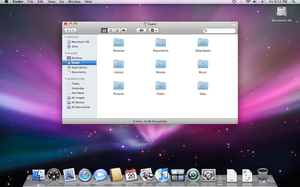
Back ماك أو إس إكس ليوبارد Arabic Mac OS X Leopard BS Mac OS X Leopard Catalan Mac OS X Leopard German Mac OS X Leopard Spanish Mac OS X Leopard ET Mac OS X Leopard Finnish Mac OS X v10.5 French Mac OS X Leopard GL Mac OS X v10.5 IS
| Version of the macOS operating system | |
 | |
 | |
| Developer | Apple Inc. |
|---|---|
| OS family | |
| Source model | Closed, with open source components |
| General availability | October 26, 2007[2] |
| Latest release | 10.5.8 (Build 9L31a)[3] / August 13, 2009[4] |
| Update method | Apple Software Update |
| Platforms | IA-32, x86-64, PowerPC |
| Kernel type | Hybrid (XNU) |
| License | Commercial proprietary software[5] with Apple Public Source License (APSL) |
| Preceded by | Mac OS X 10.4 Tiger |
| Succeeded by | Mac OS X Snow Leopard |
| Official website | Apple - Mac OS X Leopard at the Wayback Machine (archived May 28, 2009) |
| Tagline | Add a new Mac to your Mac. |
| Support status | |
| Historical, unsupported as of about June 23, 2011, Safari support and iTunes support terminated as of 2012 as well.[6][7] Drops support for iTunes releases from iTunes 1 to 3 | |
| Part of a series on |
| macOS |
|---|
Mac OS X Leopard (version 10.5) is the sixth major release of macOS, Apple's desktop and server operating system for Macintosh computers. Leopard was released on October 26, 2007 as the successor of Mac OS X Tiger, and is available in two editions: a desktop version suitable for personal computers, and a server version, Mac OS X Server. It retailed for $129[2] for the desktop version and $499 for Server.[8] Leopard was superseded by Mac OS X Snow Leopard (version 10.6) in 2009. Mac OS X Leopard is the last version of macOS that supports the PowerPC architecture as its successor, Mac OS X Snow Leopard, functions solely on Intel based Macs.
According to Apple, Leopard contains over 300 changes and enhancements compared to its predecessor, Mac OS X Tiger,[9] covering core operating system components as well as included applications and developer tools. Leopard introduces a significantly revised desktop, with a redesigned Dock, Stacks, a semitransparent menu bar, and an updated Finder that incorporates the Cover Flow visual navigation interface first seen in iTunes. Other notable features include support for writing 64-bit graphical user interface applications, an automated backup utility called Time Machine, support for Spotlight searches across multiple machines, and the inclusion of Front Row and Photo Booth, which were previously included with only some Mac models.
Apple missed Leopard's release time frame as originally announced by Apple's CEO Steve Jobs. When first discussed in June 2005, Jobs had stated that Apple intended to release Leopard at the end of 2006 or early 2007.[10] A year later, this was amended to Spring 2007;[11] however, on April 12, 2007, Apple issued a statement that its release would be delayed until October 2007 because of the development of the iPhone.[12]
Mac OS X Leopard is the first version of Mac OS X to run on the MacBook Air.
- ^ "Mac OS X Version 10.5 on Intel-based Macintosh computers". The Open Group. Archived from the original on May 11, 2008. Retrieved December 4, 2014.
- ^ a b "Apple to Ship Mac OS X Leopard on October 26". Apple Inc. October 16, 2007. Archived from the original on January 28, 2018. Retrieved January 11, 2018.
- ^ Johnson, Jeff (September 1, 2009). "Apple hot-swapped Mac OS X 10.5.8". Lap Cat Software Blog. Archived from the original on February 1, 2016. Retrieved August 7, 2014.
- ^ "About the Mac OS X v10.5.8 Update". Apple Inc. Archived from the original on April 1, 2010. Retrieved August 5, 2009.
- ^ "SOFTWARE LICENSE AGREEMENT FOR MAC OS X Single Use, Family Pack and Leopard Upgrade Licenses for use on Apple-branded Systems" (PDF). apple.com. Apple Inc. Archived (PDF) from the original on March 25, 2015. Retrieved March 19, 2015.
- ^ Gregg Keizer (December 17, 2013). "Apple signals end to OS X Snow Leopard support". Computerworld. Archived from the original on April 7, 2014.
Apple provided the final update to Leopard in June 2011
- ^ "Apple retires Snow Leopard from support, leaves 1 in 5 Macs vulnerable to attacks". February 26, 2014. Archived from the original on May 28, 2014. Retrieved May 9, 2014. See the graph picture on the web
- ^ "Apple Announces Mac OS X Server Leopard" (Press release). Apple Inc. October 16, 2007. Archived from the original on February 8, 2023. Retrieved January 11, 2018.
- ^ "Mac OS X Leopard — Features - 300+ New Features". Apple Inc. October 16, 2007. Archived from the original on October 16, 2007. Retrieved October 16, 2007.
- ^ "Apple's Intel switch: Jobs' keynote transcript". CNet. June 15, 2005. Archived from the original on October 18, 2019. Retrieved April 12, 2007.
- ^ Ryan Block (August 7, 2006). "Live from WWDC 2006: Steve Jobs keynote". Engadget. Archived from the original on August 13, 2006. Retrieved August 7, 2006.
- ^ Apple Inc. (April 12, 2007). "Apple Statement" (Press release). Yahoo! Finance. Archived from the original on April 14, 2007. Retrieved April 12, 2007.